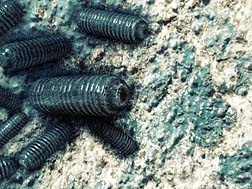 On June 26, 2009, The Wall Street Journal (WSJ) said that, according to newly released inspection reports covering the past five years, the Nestle plant refused to cooperate with the FDA--just as it had in a September 2006 visit: According to the WSJ, managers at the Danville, Va., plant refused to allow a FDA inspector to review consumer complaints or inspect its program designed to prevent food contamination. The inspector found dirty equipment and "three live ant-like insects" on a ledge. However, Nestle passed the 2006 inspection.
On June 26, 2009, The Wall Street Journal (WSJ) said that, according to newly released inspection reports covering the past five years, the Nestle plant refused to cooperate with the FDA--just as it had in a September 2006 visit: According to the WSJ, managers at the Danville, Va., plant refused to allow a FDA inspector to review consumer complaints or inspect its program designed to prevent food contamination. The inspector found dirty equipment and "three live ant-like insects" on a ledge. However, Nestle passed the 2006 inspection.Nestle has refuted the allegations of the recent reports by the WSJ, saying it "bears no relation" to the circumstances surrounding its voluntary withdrawal of Toll House products. The company said it "always cooperates with the regulatory authorities wherever it operates and is fully cooperating with the FDA at its Danville, Virginia plant with regard to this matter". Nestle also said that to date, no E.coli 0157:H7 had been found at its plant or in any Nestle facility—but not according to the FDA.
Three kinds of E. coli linked to Nestle Cookie Dough
On July 9, 2009, ABC News reported that investigators have linked at least three different kinds of E. coli to Nestle's cookie dough but they still don't know how the bacteria got in the product.
The FDA has completed DNA testing of E. coli recently found in an unopened package of cookie dough at the Danville plant. The agency determined from those tests the genetic fingerprint of the E. coli found at the plant is different than E. coli that has been linked to the foodborne illness outbreak.
Current cookie dough outbreak statistics
Current estimates place the number of illnesses with an identical E. coli O157:H7 DNA fingerprint at 74 in 32 states. At least 32 persons have required hospitalization and 10 persons have contracted hemolytic uremic syndrome. No deaths have been reported. Illness onsets began on March 16, 2009, with 72 percent of the victims being female. Ages of ill persons range from 2 to 65 years old.
Two product samples have tested positive for E. coli: an unopened 16.5 oz. Nestle Toll House refrigerated chocolate chip cookie dough sample taken from Nestle's Danville plant, and another sample taken from the home of an E. coli patient. Oddly, both samples tested positive for a different strain of E. coli than that implicated in the recent national outbreak.
Hw did E. coli get into the cookie dough?
As mentioned above, the FDA has no answer— yet.
Typically, E. coli O157:H7 is found in beef or leafy green products (products typically exposed to animal feces on the farm or in the slaughterhouse). But E. coli has never been associated with cookie dough. Neither beef nor leafy greens are ingredients found in cookie dough. So where did the E. coli come from? It is possible that contamination occurred at Nestle's cookie dough plant in Danville, which is exactly where the FDA first began to look.
FDA investigators also examined the food surfaces, machinery, storerooms, and other areas of the plant for clues as to where the contamination could have occurred. The investigation - the results of which are codified in what is called a "483 Report" - revealed two potential sources of contamination due to unsanitary conditions:
- Workmanship of equipment did not provide for proper cleaning - food contact surfaces on gate valves to food hoppers could not be cleaned easily.
- Manufacturing systems were not maintained in appropriate sanitary condition - drippings from ice condensate were found on tools used to scrape cookie dough from mixer onto the dough tray.
Neither was considered the cause of the outbreak.
While the FDA has now wrapped up its investigation of the Danville plant, inspectors are still searching for an explanation of how any E. coli got into the dough. "The investigation is winding up. It is not exactly over yet," said Dr. David Acheson, the assistant commissioner for food safety. "But we have not figured out the likely ingredient."
Dr. Acheson said FDA investigators at one time suspected wheat flour as a "plausible" source of the E. coli contamination because wheat flour is a raw agricultural ingredient that could be contaminated by wild animals such as deer. Investigators, however, didn't find E. coli at Nestle's flour. The dough also could have been cross-contaminated if it were next to a processing line for raw product, Dr. Acheson said. But production lines at Nestle's Danville plant are separated.
In fact, Acheson said, investigators may have exhausted all of their leads. "We've followed everything that we think is most likely and haven't come up with anything," Acheson said. "It is unlikely that we will ever make a final determination of how this contamination occurred." The FDA does not, however, believe this was a case of product tampering. "There's no indication that this was deliberate," Acheson said.
READ MORE FOODBORNE ILLNESS LEGAL NEWS
Nestle has resumed cookie dough production
Nestle spokeswoman Laurie MacDonald has stated that the company dismantled its entire production line, inspected and cleaned all the parts, and reassembled them. She said Nestle has also discarded all ingredients that had been stockpiled and replaced them with new flour, eggs, margarine and other items. Nestle has now restarted production of its cookie dough products.
McDonald assured reporters that before any ingredient goes into cookie dough in the future, it will undergo "very extensive pre-testing."
